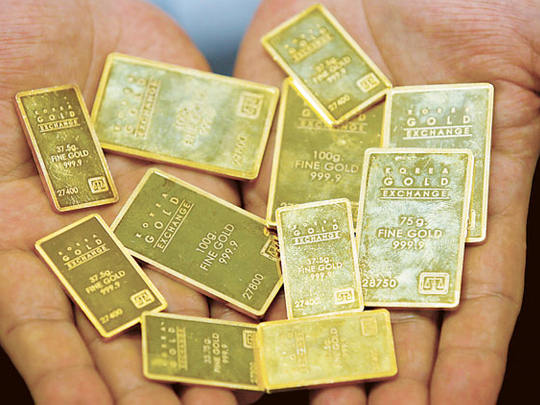
London: Gold demand fell 15 per cent in 2013 as huge outflows from physically backed investment funds outweighed record consumer demand, but that heavy disinvestment is tailing off this year, pointing to a recovery, the World Gold Council said on Tuesday.
Massive liquidation of bullion-backed exchange-traded funds returned 881 tonnes of gold to the market last year, part of a 51 per cent slump in investment demand to 773.3 tonnes.
That helped drive gold prices to their biggest annual loss in 32 years, which in turn pushed up consumer buying of the metal. Demand for gold jewellery, coins and bars rose 21 per cent to its highest on record, at 3,863.5 tonnes, the WGC said.
With that side of the market expected to hold firm, gold prices could recover this year as selling from ETFs tails off, it added. Already this year, the largest gold ETF, New York’s SPDR Gold Trust, has reported a small inflow.
“You’re seeing a significant change in the behaviour of those ETFs,” the WGC’s managing director for investment, Marcus Grubb, said. “Notwithstanding that the year is yet young, you are certainly going to see a much better year for investment and ETFs than you did last year.” “The market is getting back to balance. Futures sentiment is improving too, with the increase in net longs back to nearly 10 million ounces,” he said. “Overall, it leads us to think this will be a better year for gold than last year ... we expect to see a positive return this year.” Overall demand slid to a four-year low last year, at 3,756 tonnes, the WGC said. There was an “unprecedented” flow of gold from Western vaults to Eastern markets, via refiners in North America, Switzerland and Dubai, it added.
China overtook India as the world’s biggest gold consumer, with overall demand of 1,065.8 tonnes, largely driven by a 29 per cent rise in Chinese jewellery demand and a 38 per cent increase in coin and bar buying.
“We would expect to see Chinese demand to remain very strong at similar levels (to last year), but it’s unlikely to exceed the levels reached last year,” Grubb said.
He said the difference between the amount of gold going into China and measured demand suggested that a lot of metal remained in the inventory chain, ready to meet demand.
Jewellery demand hits high
China bucked the trend in developing markets for lower scrap supply — which fell 14 per cent globally to 1,371.4 tonnes, its lowest since 2008 — to show an increase in recycled gold returning to the market.
“The surge in demand (in China) seen in 2013, with consumers making opportunistic purchases at lower prices, does increase the prospect of a resurgence in recycling should prices rebound with any conviction,” the WGC said in the report.
Global gold jewellery demand rose to a five-year high of 2,209.5 tonnes, the largest volume increase since 1997, the WGC said. Indian jewellery demand also rose 11 per cent to 612.7 tonnes, while buying in the United States rose for the first time since 2001, to 122.8 tonnes.
Demand for smaller gold investment products like coins and bars also rose 38 per cent in China and 16 percent in India last year, with buying also rising sharply in Thailand, South Korea, and the Middle East, particularly Egypt. Turkish coin and bar demand more than doubled to 102 tonnes.
Central bank buying fell to its lowest in three years, down by nearly a third to 368.6 tonnes. This was driven in part by the last year’s price volatility, Grubb said.
“Effectively one of the reasons the slowdown happened was the increased volatility of the gold price, which is certainly looking better this year so far,” he said. “That did affect these longer term programmes last year.”
“Overall we still think you’ll see a strong year for central banks (in 2014), probably similar to last year.” On the supply side of the market, mine supply rose again by around 5 per cent to 1,968.5 tonnes, a record high.











